仁爱版七年级英语下册课件 3AUnit 5 Topic 2 A few students are running around the playground 课件(共76张PPT)
文档属性
| 名称 | 仁爱版七年级英语下册课件 3AUnit 5 Topic 2 A few students are running around the playground 课件(共76张PPT) |  | |
| 格式 | zip | ||
| 文件大小 | 13.6MB | ||
| 资源类型 | 教案 | ||
| 版本资源 | 科普版 | ||
| 科目 | 英语 | ||
| 更新时间 | 2017-03-30 20:00:32 | ||
图片预览






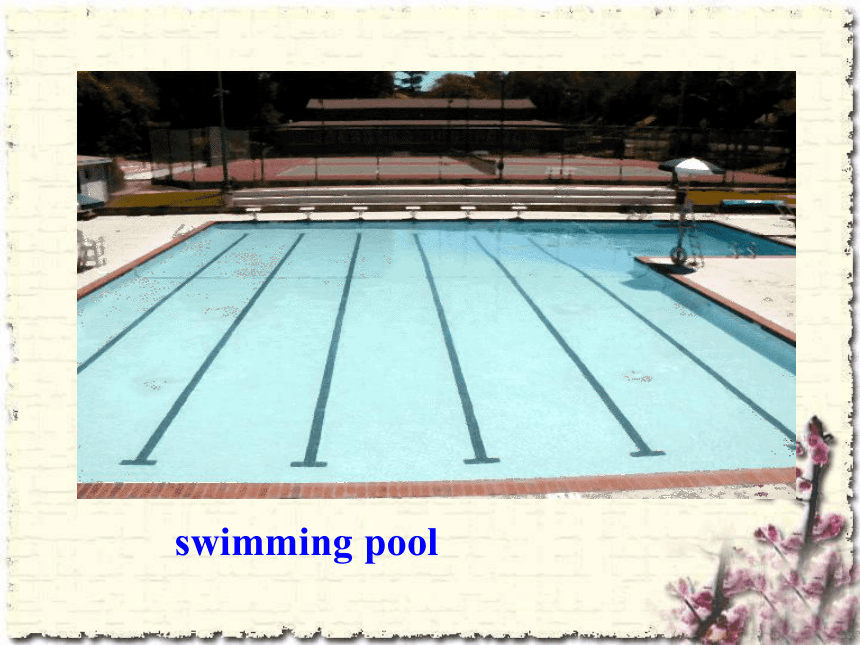
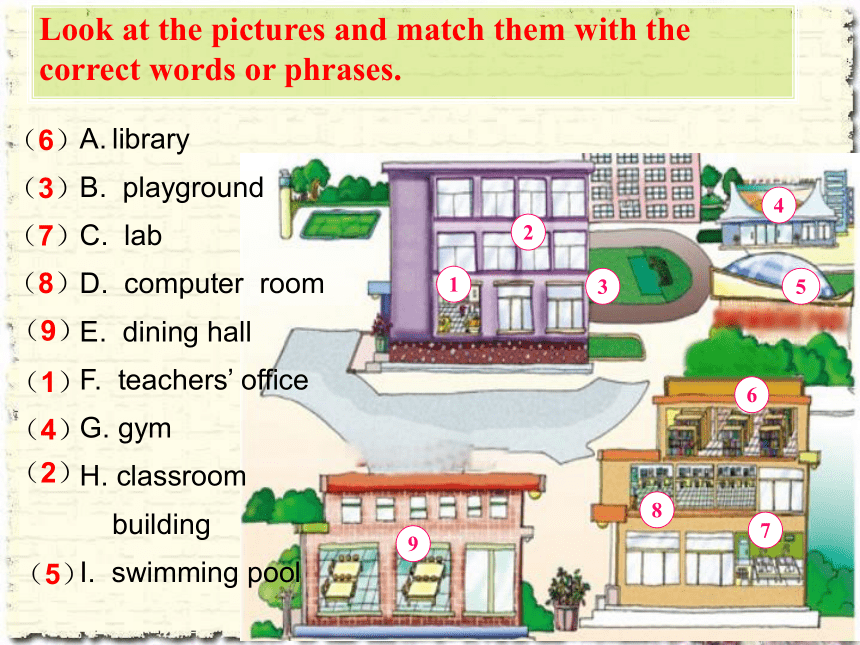

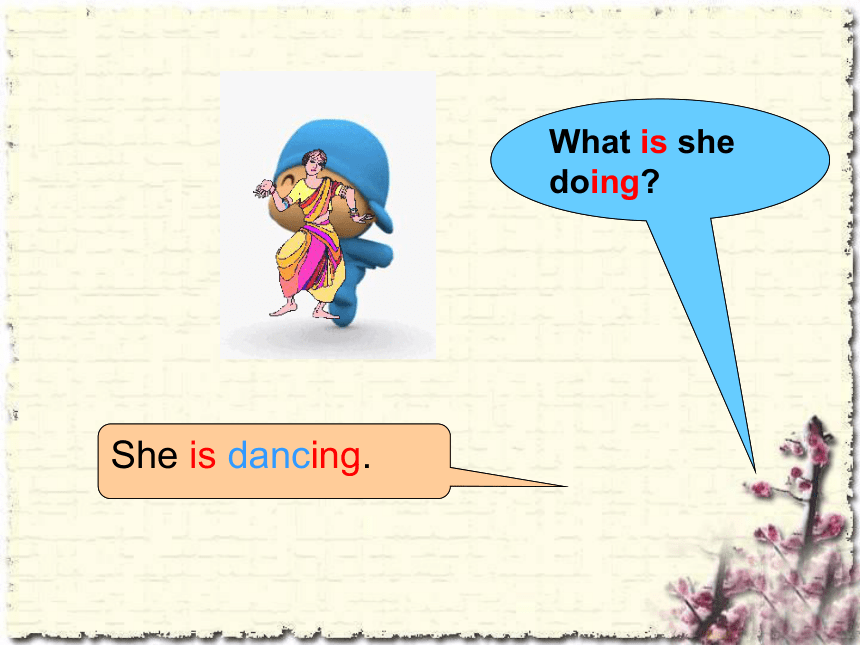
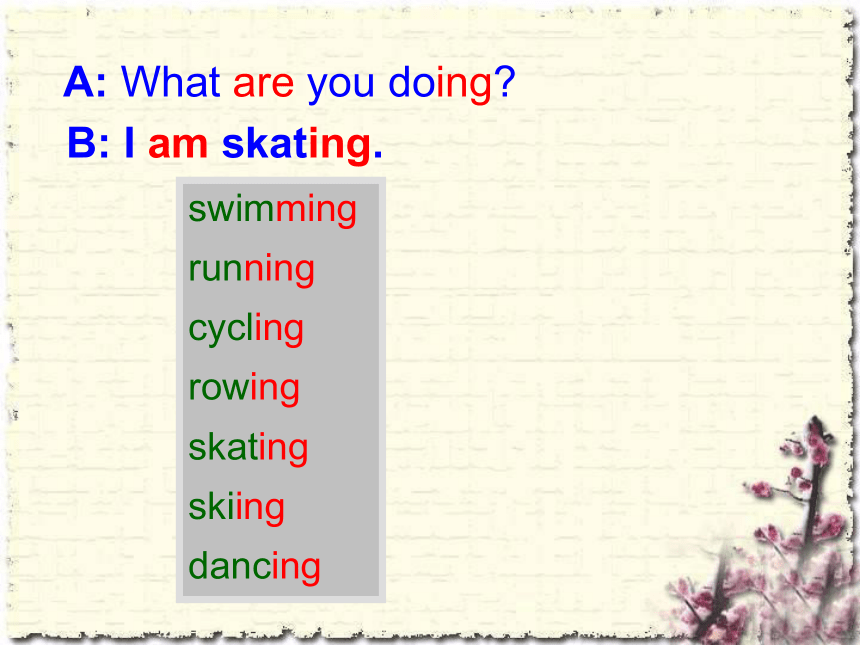
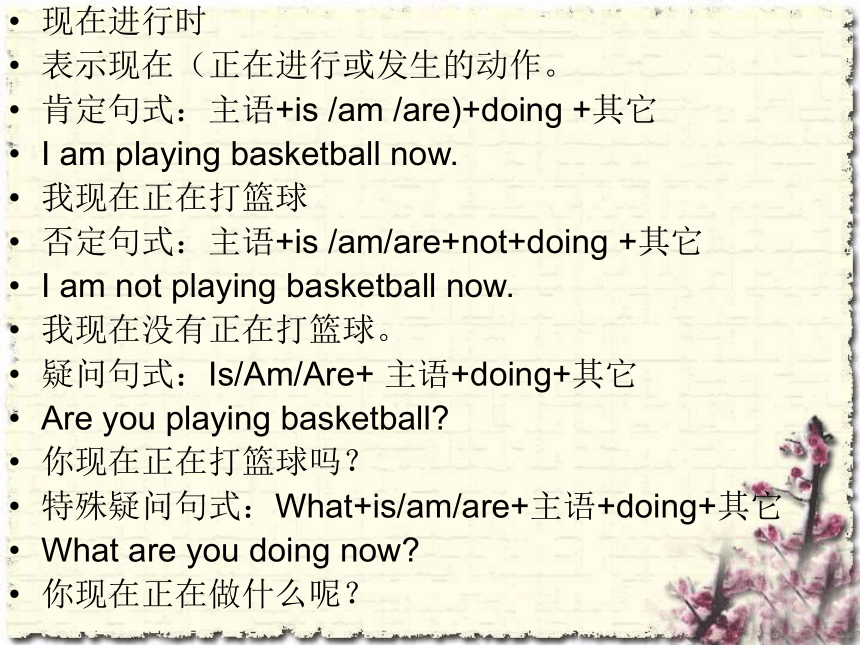
文档简介
课件76张PPT。Topic 2 A few students are running around the playground.Unit 5 Our School Life Section AHow do you like your school life?福州四十中 www.fzssz.comNew Wordsplaygroundcomputer roomlibrarylab = laboratory dining hallgymclassroom buildingteachers’ officeswimming pool1482537Look at the pictures and match them with the correct words or phrases. 96(6)(8)(9)(1)(4)(2)(5)(3)(7)library
B. playground
C. lab
D. computer room
E. dining hall
F. teachers’ office
G. gym
H. classroom building
I. swimming poolWhat are they doing?They are cleaning the classroom.Look, what is he doing?He is running.What is she doing?She is dancing. A: What are you doing?swimming
running
cycling
rowing
skating
skiing
dancingB: I am skating.现在进行时
表示现在(正在进行或发生的动作。
肯定句式:主语+is /am /are)+doing +其它
I am playing basketball now.
我现在正在打篮球
否定句式:主语+is /am/are+not+doing +其它
I am not playing basketball now.
我现在没有正在打篮球。
疑问句式:Is/Am/Are+ 主语+doing+其它
Are you playing basketball?
你现在正在打篮球吗?
特殊疑问句式:What+is/am/are+主语+doing+其它
What are you doing now?
你现在正在做什么呢?
动词 v.-ing的构成形式Grammarwash
catch
make
ride
sit
getwashing
catching
making
riding
sitting
getting一般在动词原形末尾加-ing以不发音的e结尾的动词,先去掉e,再加-ing以重读闭音节结尾的动词,如果末尾只有一个辅音字母,应先双写这个字母,再加-ingListen, look and say.Michael: Hello, Jane! This is Michael. What are you doing now?
Jane: Guess!
Michael: Are you doing your homework?
Jane: No, I’m not.
Michael: Are you watching TV?
Jane: Yes, I am. What about you?
Michael: I’m making cards, but it’s boring.
Would you like to play basketball?
Jane: Good idea! See you soon.
Michael: See you.P9 1a
视频1 Are you doing your homework?
是现在进行时的一般疑问句,肯定回答:
Yes,主语+be;否定回答:
No,主语+be+not。
e.g.—Are you reading books?
你在看书吗?
—Yes, I am./No, I’m not.
是的,我在看书。/不,我没在看书。
2 Would you like to play basketball?
你要不要去打篮球呢?
Would you like to do...?
你想或愿意做……吗?
相当于Do you want to do...?Work in pairs. Make up conversations with the information in 3a.Example:
A: ..., where is Maria?
B: She is ...
A: What is she doing now?
B: She is ...
A: Is Kangkang reading in the library, too?
B: No, he isn't. He is ...用现在进行时完成下列句子:
1. What ______ you ________(do)?
2. I____________ (sing) an English song.
3. What _____she ____________(drink)?
4. He___________ (drive) a car.
5. _____ you _______(fly) a kite?
Yes, _______.
6. ____ she ________ (sit) in the boat?
7. ______you ________ (ask) questions?
8. We___________ (play) games now.are playingdoingaream singingisdrinkingis drivingAre flying I am IssittingAreaskingExercisesread the sounds and words aloud.read the sounds and words aloud.Read aloud and compare the sounds of the colored letters./i:-e/ sea head need neck even ever weak dead
/E-?:/ again early paper person worker work winter word
/g-dZ/ bag page league large grow age guest orange
( )1.—Mr. Green gets up very early every morning.
—Yes, so he always goes to work ______ time.
A. on B. at C. next D. this
( )2.—Would you like to come and play soccer, Jim?
—_____
A. No, I wouldn’t. B. Good idea! C. Thank you. D. You’re right.
( )3.—Where are Jim and Tom? Their mother is looking for them.
—They _____ over there.
A. run B. runs C. are running D. runningCBAUnit 5 Our School Life Section BTopic 2 A few students are running around the playground.写出下列动词的现在分词:1. watch
2. play
3. shop
4. make
5. see
6. catch
7. get
8. begin9. meet
10. take
11. swim
12. write
13. teach
14. tell
15. have
16. sitwatchingsittinghavingtellingteachingwritingswimmingtakingmeetingbeginninggettingcatchingseeingmakingshoppingplayingPair WorkWhere is she?
She is __________.
Is she __________?
Yes, she___ . in the gymdancingisPair WorkA: Where are they?
B: ___________________________
A: What are they doing?
B: ____________________________They are on the playground.
They are playing basketball.on the playgroundplay basketballA: __________________
B: __________________
A: ___________________
B: ________________________He is in the classroom.
He is reading the newspaper.in the classroomread the newspaperWhere is he?What is he doing?Pair WorkA: …
B: …
A: …
B: …in the library
borrow booksPair WorkSs: They are looking for the books on the shelves.T: What are they doing?shelf
(pl.) shelves 1 May I borrow some Workbooks?
我可以借一些仁爱英语练习册吗?
此句是表达请求允许的句型。
may在此表示请求对方许可,常用 Yes, please./Yes, of course. /Certainly. 等来作肯定回答。
e.g.—May I come in?
我可以进来吗?
—Yes, please.
可以,请吧。
当作否定回答时应用mustn’t。
e.g.— May I use your phone?
我可以用你的电话吗?
—No, you mustn’t.
不,不可以。2 look for
意为“寻找”,强调找的动作;find意为“ 找到、发现”,强调找的结果。
e.g. I’m looking for my pen everywhere, but I can not find it.
我在到处找我的钢笔,但我没找到。2) how long意为“多长时间,多久”;how often 意为“多久一次”
e.g. How long is the course?
这门课程开多久?
How often do you go to the gym?
你多久去一次体育馆
3 How long can I keep them?
1)英语中借东西可以用borrow, lend, keep来表达。
borrow表示主语借进,
borrow sth. from sb.
向某人借某物。
e.g. May I borrow a pen from you?
我可以向你借支钢笔吗?
lend表示主语借出,
lend sb. sth. (lend sth. to sb.)
把某物借给某人。
e.g. I can lend you a book.
我可以借给你一本书。
keep表示借多长时间,意为“保存,保留”。
e.g. You can keep the book for two days.
这本书你能借两天。on time 意为“准时,按时”。
e.g. We must get to school on time.
我们必须按时到校。
in time 意为“及时”。(区别技巧:埃I及: I开头的是及时)
e.g. The nurse gets there in time, and she is looking after the little boy now.
护士及时赶到那儿,她现在正在照顾那个小男孩。Work in pairs and practice 1a. Then make up new conversations about borrowing things from others. Key sentences:Excuse me, may/can/could I borrow …?
Excuse me, do you have…?
Of course. / Sorry,…
How long can I keep it/them?
You must return it/them on time.
Thank you. / Thank you all the same. New Words What's this?
It's a ________.
What's in it?
_____________________________A photo, some money and cards.walletLost and Found New Words ( )4.—Lin Tao, do you want to visit the Great Wall, _______?
—Sure, Wen Wei ______ wants to.
A. also; too B. too; too C. too; also D. also; also
( )5.—Excuse me, _____ I borrow this book?
—Of course.
A. am B. may C. must D. where
( )6.—How long can I _____ the VCD?
—A week.
A. borrow B. see C. buy D. keepDBBUnit 5 Our School Life Section CTopic 2 A few students are running around the playground.in the library
on the playgroundin the computer roomin the dining hallin the teachers’ officein the swimming pool在图书馆在操场上在电脑室 在食堂 在办公室 在游泳池ReviewWhat are they doing now?
They are playing ping-pong.
What is he doing?
He is sitting and watching.write a letterA:
B:Look, what is she doing?She is writing a letter.What are they doing now? They are playing soccer. They are having a soccer game.A:
B:have lessonsA: Look,
B: what are they doing?They are having lessons.Look at the pictures and describe what the students are doing.Some students are playing basketball.Some students are having a soccer game.A few students are running around the playground.
...Look at the pictures and describe what the students are doing.插入新教材P13 1a 图 2Some girls are dancing.Three students are swimming in the swimming pool.Helen and Ann are playing ping-pong.Look at the pictures and describe what the students are doing.Kangkang is reading English newspapers.Michael is doing his homework.Wang Wei is writing a letter.Sally is cleaning the blackboard at the back of the classroom.1 show sb. around
领某人参观;带“几某人巡视
e.g. Uncle Wang is showing us around the farm.
王叔叔正带着我们参观农场。
2 few
很少。few修饰可数名词复数,意为乎没有”,表示否定含义;
a few 后接可数名词的复数,意为“几个,一些”,表示肯定的含义。
e.g.a few days
几天;
few apples
几乎没有苹果。
little 和a little修饰不可数名词。little表示否定的含义,a little表示肯定的含义。e.g. I have little water.
我几乎没水了。(有否定含义)
I have a little water.
我有一点儿水。(有肯定含义)3 write a letter
写信
write (a letter) to sb.
给某人写信
e.g. Maria is writing to Kangkang.
玛丽亚在给康康写信。
write (a letter) back to sb.
给某人回信
e.g. Kangkang is writing (a letter) back to his friend.
康康在给他的朋友回信。
3 at the back of
意为“在……后部”。指在范围内部的后部。
e.g. at the back of a house
在屋子的后部
Look at the pictures and complete the sentences.Example:
The boy is drawing pictures.
He isn't cleaning the blackboard.1. The girl _______ her homework.
She _____________ a letter.is doingisn’t writingLook at the pictures and complete the sentences.Look at the pictures and complete the sentences.2. The girls ___________ oranges.
They _______________ orange juice.are eatingaren’t drinkingLook at the pictures and complete the sentences.3. I _____________ to music.
I ________________ a song.am listeningam not singingLook at the pictures and complete the sentences.4. The man ______________ TV.
He __________ on a computer.isn’t watchingis playingLook at the pictures and complete the sentences.5. The students _____________ games.
They __________ an English class.aren’t playingare havingAsk and answer questions with the information in 2a.Example:
A: Is the boy cleaning the blackboard?
B: No, he isn't.
A: What is he doing?
B: He is drawing pictures.( )7.—What are you doing?
—I’m _____ my English book.
A. looking after B. looking at C. looking for D. looking like
( )8.—Could you give me _____ English newspapers?
—Of course. Here you are.
A. a little B. a lot C. a few D. much
( )9.—You must _____ a letter to your mother tomorrow.
—Well, I will, Dad.
A. write B. to write C. write to D. writing
( )10.—Excuse me, do you have any basketballs?
—Sorry, we don’t have any.
—_____
A. Oh, I want to buy it. B. Thank you all the same.
C. Bye-bye. D. It doesn’t matter.ACCBUnit 5 Our School Life Section DTopic 2 A few students are running around the playground.Guess what Jim is doing in the classroom.Guessing GameIs Jim ... in the classroom?Yes? No?Yes, he is listening to music in the classroom.Guess what they are doing in the gym.Guessing GameAre they ... in the gym?Yes? No? Yes, they are dancing in the gym.?Guess what Kangkang is doing on the playground.Guessing gameIs he ... on the playground?Yes? No?Yes, he is playing ping-pong with Michael on the playground.? Write down the V-ing forms of the verbs.
① play ② watch
③ make ④ swim
⑤ sing ⑥ have
⑦ do ⑧ sleep
⑨ come ⑩ putplayingwatchingmakingswimmingsinginghavingdoingsleepingcomingputtingPresent ContinuousGrammarAreIsArethey aren'tPresent ContinuousGrammarI'mHe's/She'sThey'remay I borrowFunctions How long1 Here are some photos of his.
他的一些照片在这儿。
1)此句是倒装句。here, there 等副词置于句首时,经常与 go, come 等动词连用。主语如为普通名词全句需要完全倒装;主语如为代词,不需倒装。
e.g. There goes the bell.
铃响了。
Here he comes.
他来了。
名词在两边,代词在中间。
2)some photos of his 他的一些照片,此处是双重所有格的用法。of 后可以是名词性物主代词,也可以是表示具体的人的名词所有格。
e.g. a friend of my father’s
我父亲的一位朋友
3) love doing sth. 喜欢做某事
4 1)talk to sb. = talk with sb.
和某人交谈
e.g. I often talk to/with him.
我经常和他谈心。5 also 也,常用于句子中;表肯定
too 也,用于句末,通常有逗号与前面句子隔开,表肯定。
either 也, 句末,表否定。
e.g. He also likes apples.
= He likes apples, too.
他也喜欢吃苹果。
6 one day
(将来或过去)有一天
e.g. I will go to Hong Kong one day.
总有一天我会去香港。Here are some photos of his.
photos of his 双重所有格,his 在此用作名词性物主代词。
He looks happy because he loves swimming.
love doing sth.
a Japanese girl
The Great Wall is wonderful.
I also want to visit it one day.
also与too都表示“也”,also常用于句中,too 用于句末。Key PointsThank you
B. playground
C. lab
D. computer room
E. dining hall
F. teachers’ office
G. gym
H. classroom building
I. swimming poolWhat are they doing?They are cleaning the classroom.Look, what is he doing?He is running.What is she doing?She is dancing. A: What are you doing?swimming
running
cycling
rowing
skating
skiing
dancingB: I am skating.现在进行时
表示现在(正在进行或发生的动作。
肯定句式:主语+is /am /are)+doing +其它
I am playing basketball now.
我现在正在打篮球
否定句式:主语+is /am/are+not+doing +其它
I am not playing basketball now.
我现在没有正在打篮球。
疑问句式:Is/Am/Are+ 主语+doing+其它
Are you playing basketball?
你现在正在打篮球吗?
特殊疑问句式:What+is/am/are+主语+doing+其它
What are you doing now?
你现在正在做什么呢?
动词 v.-ing的构成形式Grammarwash
catch
make
ride
sit
getwashing
catching
making
riding
sitting
getting一般在动词原形末尾加-ing以不发音的e结尾的动词,先去掉e,再加-ing以重读闭音节结尾的动词,如果末尾只有一个辅音字母,应先双写这个字母,再加-ingListen, look and say.Michael: Hello, Jane! This is Michael. What are you doing now?
Jane: Guess!
Michael: Are you doing your homework?
Jane: No, I’m not.
Michael: Are you watching TV?
Jane: Yes, I am. What about you?
Michael: I’m making cards, but it’s boring.
Would you like to play basketball?
Jane: Good idea! See you soon.
Michael: See you.P9 1a
视频1 Are you doing your homework?
是现在进行时的一般疑问句,肯定回答:
Yes,主语+be;否定回答:
No,主语+be+not。
e.g.—Are you reading books?
你在看书吗?
—Yes, I am./No, I’m not.
是的,我在看书。/不,我没在看书。
2 Would you like to play basketball?
你要不要去打篮球呢?
Would you like to do...?
你想或愿意做……吗?
相当于Do you want to do...?Work in pairs. Make up conversations with the information in 3a.Example:
A: ..., where is Maria?
B: She is ...
A: What is she doing now?
B: She is ...
A: Is Kangkang reading in the library, too?
B: No, he isn't. He is ...用现在进行时完成下列句子:
1. What ______ you ________(do)?
2. I____________ (sing) an English song.
3. What _____she ____________(drink)?
4. He___________ (drive) a car.
5. _____ you _______(fly) a kite?
Yes, _______.
6. ____ she ________ (sit) in the boat?
7. ______you ________ (ask) questions?
8. We___________ (play) games now.are playingdoingaream singingisdrinkingis drivingAre flying I am IssittingAreaskingExercisesread the sounds and words aloud.read the sounds and words aloud.Read aloud and compare the sounds of the colored letters./i:-e/ sea head need neck even ever weak dead
/E-?:/ again early paper person worker work winter word
/g-dZ/ bag page league large grow age guest orange
( )1.—Mr. Green gets up very early every morning.
—Yes, so he always goes to work ______ time.
A. on B. at C. next D. this
( )2.—Would you like to come and play soccer, Jim?
—_____
A. No, I wouldn’t. B. Good idea! C. Thank you. D. You’re right.
( )3.—Where are Jim and Tom? Their mother is looking for them.
—They _____ over there.
A. run B. runs C. are running D. runningCBAUnit 5 Our School Life Section BTopic 2 A few students are running around the playground.写出下列动词的现在分词:1. watch
2. play
3. shop
4. make
5. see
6. catch
7. get
8. begin9. meet
10. take
11. swim
12. write
13. teach
14. tell
15. have
16. sitwatchingsittinghavingtellingteachingwritingswimmingtakingmeetingbeginninggettingcatchingseeingmakingshoppingplayingPair WorkWhere is she?
She is __________.
Is she __________?
Yes, she___ . in the gymdancingisPair WorkA: Where are they?
B: ___________________________
A: What are they doing?
B: ____________________________They are on the playground.
They are playing basketball.on the playgroundplay basketballA: __________________
B: __________________
A: ___________________
B: ________________________He is in the classroom.
He is reading the newspaper.in the classroomread the newspaperWhere is he?What is he doing?Pair WorkA: …
B: …
A: …
B: …in the library
borrow booksPair WorkSs: They are looking for the books on the shelves.T: What are they doing?shelf
(pl.) shelves 1 May I borrow some Workbooks?
我可以借一些仁爱英语练习册吗?
此句是表达请求允许的句型。
may在此表示请求对方许可,常用 Yes, please./Yes, of course. /Certainly. 等来作肯定回答。
e.g.—May I come in?
我可以进来吗?
—Yes, please.
可以,请吧。
当作否定回答时应用mustn’t。
e.g.— May I use your phone?
我可以用你的电话吗?
—No, you mustn’t.
不,不可以。2 look for
意为“寻找”,强调找的动作;find意为“ 找到、发现”,强调找的结果。
e.g. I’m looking for my pen everywhere, but I can not find it.
我在到处找我的钢笔,但我没找到。2) how long意为“多长时间,多久”;how often 意为“多久一次”
e.g. How long is the course?
这门课程开多久?
How often do you go to the gym?
你多久去一次体育馆
3 How long can I keep them?
1)英语中借东西可以用borrow, lend, keep来表达。
borrow表示主语借进,
borrow sth. from sb.
向某人借某物。
e.g. May I borrow a pen from you?
我可以向你借支钢笔吗?
lend表示主语借出,
lend sb. sth. (lend sth. to sb.)
把某物借给某人。
e.g. I can lend you a book.
我可以借给你一本书。
keep表示借多长时间,意为“保存,保留”。
e.g. You can keep the book for two days.
这本书你能借两天。on time 意为“准时,按时”。
e.g. We must get to school on time.
我们必须按时到校。
in time 意为“及时”。(区别技巧:埃I及: I开头的是及时)
e.g. The nurse gets there in time, and she is looking after the little boy now.
护士及时赶到那儿,她现在正在照顾那个小男孩。Work in pairs and practice 1a. Then make up new conversations about borrowing things from others. Key sentences:Excuse me, may/can/could I borrow …?
Excuse me, do you have…?
Of course. / Sorry,…
How long can I keep it/them?
You must return it/them on time.
Thank you. / Thank you all the same. New Words What's this?
It's a ________.
What's in it?
_____________________________A photo, some money and cards.walletLost and Found New Words ( )4.—Lin Tao, do you want to visit the Great Wall, _______?
—Sure, Wen Wei ______ wants to.
A. also; too B. too; too C. too; also D. also; also
( )5.—Excuse me, _____ I borrow this book?
—Of course.
A. am B. may C. must D. where
( )6.—How long can I _____ the VCD?
—A week.
A. borrow B. see C. buy D. keepDBBUnit 5 Our School Life Section CTopic 2 A few students are running around the playground.in the library
on the playgroundin the computer roomin the dining hallin the teachers’ officein the swimming pool在图书馆在操场上在电脑室 在食堂 在办公室 在游泳池ReviewWhat are they doing now?
They are playing ping-pong.
What is he doing?
He is sitting and watching.write a letterA:
B:Look, what is she doing?She is writing a letter.What are they doing now? They are playing soccer. They are having a soccer game.A:
B:have lessonsA: Look,
B: what are they doing?They are having lessons.Look at the pictures and describe what the students are doing.Some students are playing basketball.Some students are having a soccer game.A few students are running around the playground.
...Look at the pictures and describe what the students are doing.插入新教材P13 1a 图 2Some girls are dancing.Three students are swimming in the swimming pool.Helen and Ann are playing ping-pong.Look at the pictures and describe what the students are doing.Kangkang is reading English newspapers.Michael is doing his homework.Wang Wei is writing a letter.Sally is cleaning the blackboard at the back of the classroom.1 show sb. around
领某人参观;带“几某人巡视
e.g. Uncle Wang is showing us around the farm.
王叔叔正带着我们参观农场。
2 few
很少。few修饰可数名词复数,意为乎没有”,表示否定含义;
a few 后接可数名词的复数,意为“几个,一些”,表示肯定的含义。
e.g.a few days
几天;
few apples
几乎没有苹果。
little 和a little修饰不可数名词。little表示否定的含义,a little表示肯定的含义。e.g. I have little water.
我几乎没水了。(有否定含义)
I have a little water.
我有一点儿水。(有肯定含义)3 write a letter
写信
write (a letter) to sb.
给某人写信
e.g. Maria is writing to Kangkang.
玛丽亚在给康康写信。
write (a letter) back to sb.
给某人回信
e.g. Kangkang is writing (a letter) back to his friend.
康康在给他的朋友回信。
3 at the back of
意为“在……后部”。指在范围内部的后部。
e.g. at the back of a house
在屋子的后部
Look at the pictures and complete the sentences.Example:
The boy is drawing pictures.
He isn't cleaning the blackboard.1. The girl _______ her homework.
She _____________ a letter.is doingisn’t writingLook at the pictures and complete the sentences.Look at the pictures and complete the sentences.2. The girls ___________ oranges.
They _______________ orange juice.are eatingaren’t drinkingLook at the pictures and complete the sentences.3. I _____________ to music.
I ________________ a song.am listeningam not singingLook at the pictures and complete the sentences.4. The man ______________ TV.
He __________ on a computer.isn’t watchingis playingLook at the pictures and complete the sentences.5. The students _____________ games.
They __________ an English class.aren’t playingare havingAsk and answer questions with the information in 2a.Example:
A: Is the boy cleaning the blackboard?
B: No, he isn't.
A: What is he doing?
B: He is drawing pictures.( )7.—What are you doing?
—I’m _____ my English book.
A. looking after B. looking at C. looking for D. looking like
( )8.—Could you give me _____ English newspapers?
—Of course. Here you are.
A. a little B. a lot C. a few D. much
( )9.—You must _____ a letter to your mother tomorrow.
—Well, I will, Dad.
A. write B. to write C. write to D. writing
( )10.—Excuse me, do you have any basketballs?
—Sorry, we don’t have any.
—_____
A. Oh, I want to buy it. B. Thank you all the same.
C. Bye-bye. D. It doesn’t matter.ACCBUnit 5 Our School Life Section DTopic 2 A few students are running around the playground.Guess what Jim is doing in the classroom.Guessing GameIs Jim ... in the classroom?Yes? No?Yes, he is listening to music in the classroom.Guess what they are doing in the gym.Guessing GameAre they ... in the gym?Yes? No? Yes, they are dancing in the gym.?Guess what Kangkang is doing on the playground.Guessing gameIs he ... on the playground?Yes? No?Yes, he is playing ping-pong with Michael on the playground.? Write down the V-ing forms of the verbs.
① play ② watch
③ make ④ swim
⑤ sing ⑥ have
⑦ do ⑧ sleep
⑨ come ⑩ putplayingwatchingmakingswimmingsinginghavingdoingsleepingcomingputtingPresent ContinuousGrammarAreIsArethey aren'tPresent ContinuousGrammarI'mHe's/She'sThey'remay I borrowFunctions How long1 Here are some photos of his.
他的一些照片在这儿。
1)此句是倒装句。here, there 等副词置于句首时,经常与 go, come 等动词连用。主语如为普通名词全句需要完全倒装;主语如为代词,不需倒装。
e.g. There goes the bell.
铃响了。
Here he comes.
他来了。
名词在两边,代词在中间。
2)some photos of his 他的一些照片,此处是双重所有格的用法。of 后可以是名词性物主代词,也可以是表示具体的人的名词所有格。
e.g. a friend of my father’s
我父亲的一位朋友
3) love doing sth. 喜欢做某事
4 1)talk to sb. = talk with sb.
和某人交谈
e.g. I often talk to/with him.
我经常和他谈心。5 also 也,常用于句子中;表肯定
too 也,用于句末,通常有逗号与前面句子隔开,表肯定。
either 也, 句末,表否定。
e.g. He also likes apples.
= He likes apples, too.
他也喜欢吃苹果。
6 one day
(将来或过去)有一天
e.g. I will go to Hong Kong one day.
总有一天我会去香港。Here are some photos of his.
photos of his 双重所有格,his 在此用作名词性物主代词。
He looks happy because he loves swimming.
love doing sth.
a Japanese girl
The Great Wall is wonderful.
I also want to visit it one day.
also与too都表示“也”,also常用于句中,too 用于句末。Key PointsThank you
同课章节目录
- Unit 5 Our school life
- Topic 1 I usually come to school by subway.
- Topic 2 A few students are running around the play
- Topic 3 My school life is very interesting.
- Unit 6 Our local area
- Topic 1 Is there a computer in your study?
- Topic 2 My home is in an apartment building.
- Topic 3 Which is the way to the hospital?
- Review of Units 5-6
- Unit 7 The Birthday
- Topic 1 When is your birthday?
- Topic 2 Can you sing an English song?
- Topic 3 Everyone had a good time.
- Unit 8 The seasons and the Weathe
- Topic 1 What's the weather like in summer?
- Topic 2 The summer holidays are coming.
- Topic 3 Let’s celebrate!
- Review of Units 7-8
- 旧版资料
- Unit 5 Our School Life
- Unit 6 Our Local Area
- Unit 7 The Birthday
- Unit 8 The seasons and the Weathe
- Unit 7 Celebrating the Birthday(老版本)
